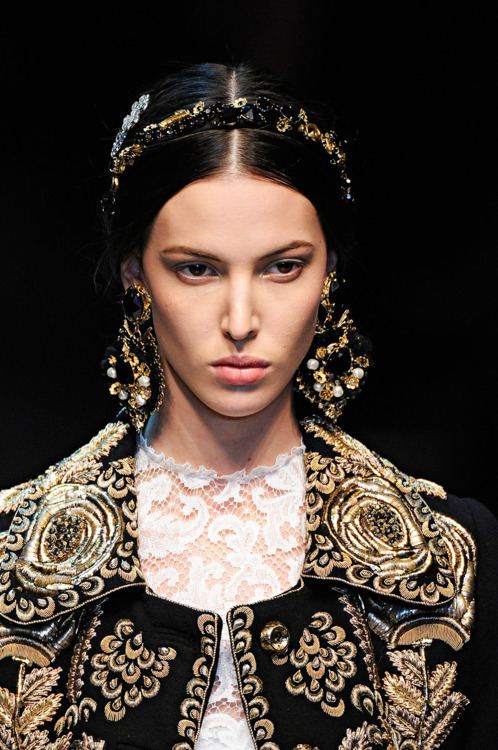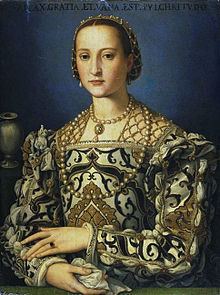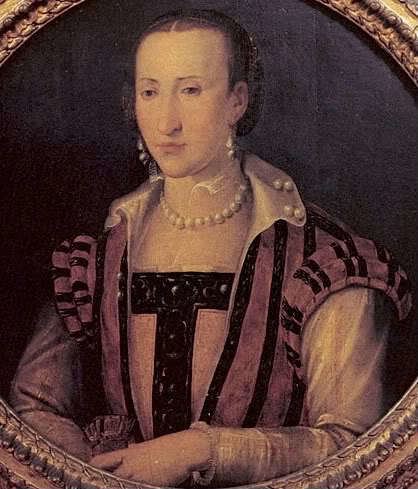Name Eleanor Toledo | Children Giovanni de' Medici | |
 | ||
Tenure 29 March 1539 – 17 December 1562 Issue MariaFrancesco I, Grand Duke of TuscanyIsabella, Duchess of BraccianoCardinal GiovanniLucrezia, Duchess of ModenaPietro de' Medici (1546–1547) (it)Garzia de' MediciFerdinando I, Grand Duke of TuscanyAnnaPietro Father Pedro Alvarez de Toledo, 2nd Marquis of Villafranca Parents Pedro Alvarez de Toledo, Marquis of Villafranca Similar People | ||
Eleanor of Toledo (Italian: Eleonora di Toledo (1522 – 17 December 1562), born Doña Leonor Álvarez de Toledo y Osorio, was a Spanish noblewoman who was Duchess of Florence from 1539, after Margaret of Austria.Although, Eleanor is often referred to as the Grand Duchess of Tuscany, she predeceased the creation of the Grand Duke of Tuscany. She is credited with being the first modern first lady, or consort. She served as regent of Florence during the absence of her spouse.
Contents

Life

Eleanor was born in Alba de Tormes, Salamanca, as the second daughter of the Viceroy of Naples, Don Pedro Álvarez de Toledo, Marquis of Villafranca (Charles V's lieutenant-governor) and Maria Osorio, 2nd Marquise of Villafranca. Her father was the second son of Fadrique Álvarez de Toledo, 2nd Duke of Alba and therefore, the 3rd Duke of Alba was his eldest brother.

Eleanor was remembered for her beauty: brunette with hazel eyes, an oval shaped face, sweet and full features of an inherent majestic quality, as evident in her portraits. Eleanor was seen as an incredibly charming bride entering the Medici household.

Cosimo was searching for a wife who could help strengthen his political position and had initially asked to marry Margaret of Austria, the widow of Duke Alessandro de’ Medici, who displayed enormous reluctance at the idea (thus serving her father’s own interest and plans for her). The Emperor, not wanting to antagonize Cosimo, offered him one of the daughters of the rich viceroy of Naples. The viceroy agreed, provided Cosimo settled a large amount of money on her as dowry. This marriage was politically beneficial as the Medici were new to their ducal status. Additionally, Eleanor's royal Castilian ancestors and relations with the Habsburgs provided the Medici with the blue blood they had hitherto lacked and began the process of placing them on a footing with other European sovereigns. Through her father, Eleanor also provided the Medici with a powerful link to Spain, at that time ultimately in control of Florence, so that the marriage offered Cosimo I the opportunity to show sufficient loyalty to and trust in Spain that Spanish troops could be withdrawn from the province.

Eleanor married Cosimo I de’ Medici in the spring of 1539 at seventeen years of age. Eleanor was married by proxy on 29 March 1539, and set sail from Naples, 11 June, accompanied by her brother Garcia with seven galleys following. They arrived at Livorno on the morning of June 22. That same morning, Eleonora left for Pisa and halfway through, met Cosimo. After a short stay in Pisa, the ducal couple left for Florence, stopping for a few days at the Poggio a Caiano. July 29 marked the grandiose entrance of Eleonora from the Porta al Prato to the church of San Lorenzo for the official wedding, in a grand and lavish celebration.

Eleanor and Cosimo had a long and peaceful married life. Surprisingly, Cosimo was faithful to Eleanor throughout their married life. Both were religious and led their lives accordingly. The ducal couple served as an example of a traditional couple, which served to strengthen Cosimo's various reforms and separate him from association with the former Duke.
Children

Eleanor and Cosimo had eleven children, including five sons who reached maturity (Francesco, Giovanni, Garzia, Ferdinando, and Pietro); before this time the Medici line had been in danger of becoming extinct. Thus by providing an heir, and ample spares, as well as through her daughters' marriages into other ruling and noble families of Italy, she was able to inaugurate an era of strength and stability in Tuscany. Two of her sons, Francesco and Ferdinando, reigned as grand Dukes of Tuscany.
Consort
Eleanor's high profile in Florence as consort was initially a public relations exercise promoted by her husband whose predecessor as first sovereign Duke Alessandro de' Medici had died without legitimate heirs after years of politically damaging speculation about his sexual irregularities and excesses; Alessandro himself was reputed to have been the son of a black serving woman, his father was the seventeen-year-old Cardinal Giulio de' Medici, later Pope Clement VII, and Clement VII was in turn the illegitimate son of Giuliano de' Medici, who was assassinated in the Pazzi Conspiracy against the Medici. Alessandro became the first sovereign ruler of Tuscany belonging to the house of Medici, but was assassinated in 1543 by another member of the Medici family, Lorenzino de' Medici, before consolidating his dynasty's strength in Tuscany. The last of the old Medici line, Alessandro bequeathed to the Medici name a legacy and reputation of sex, scandal, and murder.
Alessandro's distantly related successor, Cosimo I, needed to reassure the public of the stability and respectability of not only his family, but the new reign. Thus Eleanor, his attractive, charitable and fertile wife, was brought to the forefront, and the artist Agnolo Bronzino was commissioned to paint one of the first ever state portraits depicting a consort with her child and heir.
During her marriage, despite her initial unpopularity as a Spaniard, she gained great influence in Florence, she encouraged the arts and was patron to many of the most notable artists of the age. A pious woman, she encouraged the Jesuit order to settle in Florence; she also founded many new churches in the city. Eleanor was also interested in agriculture and business. She owned great tracts of Tuscan land that she managed effectively which, helped to expand and increase the profitability of the vast Medici estates (her products were shipped as far as Spain), and through her charitable interests, the lot of the peasantry.
She also supported unhesitatingly her husband and his policies, so much so that he consulted with her. So great was his trust in her that in his frequent absences he made her regent, a station which also established her position as more than just a pretty bearer of Medici children.
As a consequence, it became known that Eleanor was the key to her husband, and those unable to gain an audience with Cosimo realized that through his wife their causes could at least be pleaded. No evidence exists, however, to prove that she greatly influenced him; but the importance of her usefulness to him cannot be ignored.
Personality
Contemporary accounts of Eleanor belie the stern formal appearance of her many portraits. In her private capacity she loved to gamble, and she was a devoted traveller, moving endlessly from one of her palazzi to another.
She employed continually 10 gold and silver weavers to work on her apparel. She may have needed the fine clothes to disguise her failing appearance, as 21st-century forensic examinations of her body have revealed a huge calcium deficiency which must have caused her enormous amounts of ill health, and dental pain.
Legacy
Eleanor of Toledo died at Pisa from malaria in 1562. Since her death, historians have tended to overlook her importance to Florentine history, and today she is often thought of as just another Medici consort and lover of luxury. This is probably due to the numerous portraits painted of her, which always show extravagance of dress. Her funeral dress still survives and is today in the care of the Galleria del Costume in Palazzo Pitti, which she purchased in 1549 as a summer retreat, and which after her death became the principal home of the rulers of Tuscany. In the earlier part of her marriage the Medici lived in Florence's Via Larga at what is now the Palazzo Medici-Riccardi and later at the Palazzo Vecchio. The rebuilding of the Pitti Palace was only partially completed at the time of her death.
Part of Eleanor's final will and testament was the creation and funding of the prestigious and exclusive convent Santissima Concezione, the daughter house of one of Eleanor's favorite convents, Le Murate. It was built around the Sale del Papa of the prominent Dominican monastery of Santa Maria Novella, which once functioned as quarters for visiting popes. Though she would not live to see it completed, its founding following her death contributed to her legacy and the artistic commissions for the convent further reinforce the fact that Eleanor was the patron; they include “a bust of [Eleanor], and the coat of arms of the duke and duchess painted on the communion window between the sisters and the altar."
For centuries after her death the myth pervaded that her 16-year-old son Garcia had murdered his 19-year-old brother, Giovanni, following a dispute in 1562. Their father Cosimo I, it was said, then murdered Garcia with his own sword, and Eleanor, distraught, died a week later from grief. The truth, proven by modern-day exhumations and forensic science, was that Eleanor and her sons, as the Medici family had always claimed, died together from malaria in 1562.
